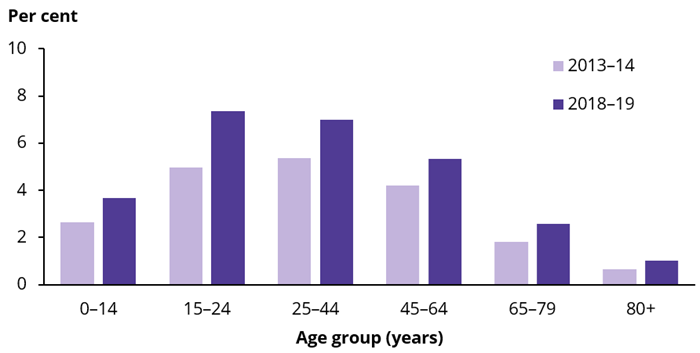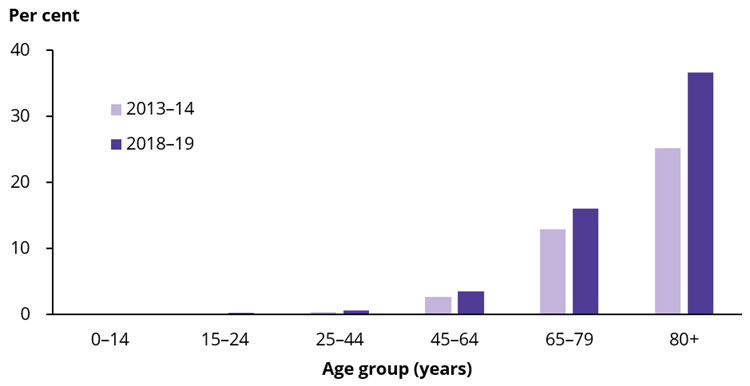Allied health services
Steady rise in the use of allied health services since 2013–14
In 2018–19, 37% of the population, or 9.4 million people, had at least one Medicare-subsidised allied health service, a steady growth from 32% in 2013–14. In the same period, the number of services rose from 73 to 96 per 100 people.
This change was driven predominantly by an increasing percentage of people who had Medicare-subsidised optometry services, physiotherapy, podiatry services, or allied mental health services (provided by a psychologist) (Table 4).
|
Service groups(b) |
2013–14 (%) |
2018–19 (%) |
Percentage point change(c) |
|---|---|---|---|
|
Allied health services(d)(e) |
32 |
37 |
5.2 |
|
Optometry(d) |
27 |
30 |
3.3 |
|
Mental health care(d)(f) |
3.9 |
5.3 |
1.3 |
|
Clinical Psychologist |
1.6 |
2.2 |
0.5 |
|
Other Psychologist |
2.2 |
2.9 |
0.7 |
|
Other Allied Mental Health |
0.3 |
0.4 |
0.2 |
|
Physical health care(d)(g) |
2.6 |
4.7 |
2.1 |
|
Physiotherapy |
1.9 |
3.4 |
1.6 |
|
Exercise Physiology |
0.4 |
0.7 |
0.3 |
|
Chiropractic Services |
0.3 |
0.6 |
0.3 |
|
Osteopathy |
0.2 |
0.3 |
0.1 |
|
Allied health – Other(d)(h) |
4.1 |
5.8 |
1.7 |
|
Podiatry |
3.1 |
4.4 |
1.3 |
|
Dietetics |
0.8 |
1.1 |
0.3 |
|
Occupational Therapy |
0.08 |
0.14 |
0.06 |
|
Speech Pathology |
0.17 |
0.21 |
0.04 |
|
Diabetes Education |
0.22 |
0.25 |
0.03 |
|
Audiology |
0.03 |
0.06 |
0.03 |
|
Other Allied Health |
0.02 |
0.05 |
0.02 |
Notes:
(a) Non-hospital Medicare-subsidised services only.
(b) Refer to Technical Information for details on MBS items and description of service groups.
(c) Discrepancies may be due to rounding of numbers.
(d) People may receive more than one subgroup service within Mental Health Care, Physical Health Care or Allied health – Other service groups, but will only be counted once in the total.
(e) Includes Optometry, Mental health care, Physical health care and Allied health – Other.
(f) Includes Clinical Psychologists, Other Psychologists and Other Allied Mental Health service groups.
(g) Includes Physiotherapy, Exercise Physiology, Chiropractic Services and Osteopathy service groups.
(h) Includes Podiatry, Dietetics, Occupational Therapy, Speech Pathology, Diabetes Education, Audiology and Other Allied Health.
Sources: AIHW analysis of Department of Health, MBS claims data; ABS ERP.
Box 6: What are Medicare-subsidised allied health services?
Allied health includes a broad range of services delivered by health practitioners who are not doctors, nurses or dentists. This includes audiologists, chiropractors, occupational therapists, optometrists, osteopaths, physiotherapists, podiatrists, psychologists and speech pathologists (AHPA 2017a). Australians eligible for Medicare-subsidised allied health services can use allied health services through many channels, including Medicare, general private health insurance (‘ancillary’ or ‘extras’ cover), or by paying for the service entirely out-of-pocket. At present, there is no national data on allied health service use outside of Medicare or private health insurance (AIHW 2018).
Who is eligible for Medicare-subsidised allied health services?
Medicare-subsidised allied health services account for only a portion of all allied health service use in Australia, and, with the exception of optometry services, are generally only available to people who are referred by a GP, or in some cases a specialist medical practitioner. Common referral pathways include GP Mental Health Treatment Plans for people with a mental health condition and GP Chronic Disease Management Plans for people with a chronic health condition (in this report these are referred to as Enhanced Primary Care GP services). For more detail, refer to the Technical Information for this release.
Allied health services subsidised by private health insurance
In 2018–19, private health insurers subsidised 52 million allied health-related services (APRA 2019). This compares with 24 million allied health services subsidised by Medicare in the same year. To assist with interpretation of Medicare-subsidised allied health services, general private health insurance data by state and territory are included in the accompanying Data tables (APRA 2019).
People aged 65 and over use allied health services more than younger age groups
Overall, older people use allied health services more than younger people. In 2018–19, 65% of people aged 65 to 79 and 72% of people aged 80 and over had an allied health service, compared with 32% of people aged under 65. However, the types of services people use changes with age.
More than one in five people aged 65 and over had a podiatry service
Allied health services including optometry, physiotherapy and podiatry were commonly used by older people. For example, 4.4% of the Australian population had a Medicare-subsidised podiatry service in 2018–19, but more than one in five people aged 65 and over (21%) used this service (Figure 6). This is likely due to chronic conditions-related complications (healthdirect 2018a). This pattern remains unchanged since 2013–14.
Figure 6: Percentage of people who had a Medicare-subsidised podiatry service, by age groups, 2013–14 and 2018–19
Chart: AIHW. Sources: AIHW analysis of Department of Health, MBS claims data; ABS ERP.
Younger Australians were more likely to see a psychologist or allied mental health care worker
Between 2013–14 and 2018–19, younger Australians were more likely to see a Medicare-subsidised psychologist or allied mental health care worker than older Australians (Figure 7). For example, in 2018–19, around 1 in 14 people (7.3%) aged 15–24 had a Medicare-subsidised allied mental health service, followed by people aged 25–44 years (7.0%).
Figure 7: Percentage of people who had a Medicare-subsidised allied mental health service, by age groups, 2013–14 and 2018–19

Chart: AIHW. Sources: AIHW analysis of Department of Health, MBS claims data; ABS ERP.
Box 7: Allied mental health telehealth services
In 2017–18, the Australian Government introduced a range of Medicare-subsidised allied mental health telehealth services. These provide psychological therapy services through video conferencing to people located in a telehealth eligible area and are provided by psychologists or allied health mental health workers such as occupational therapists or social workers. These Medicare-subsidised services are not reported separately in this publication due to small numbers at local areas. These telehealth items are included in Clinical Psychologists, Other Psychologists and Other Allied Mental Health service groups. Note, in response to the COVID-19 pandemic, the Australian Government further expanded these telehealth services from March 2020. The findings in this report precede the introduction of these new telehealth services. For further detail, see Technical Information.
Allied health service use varied across PHN areas and age groups
Across all 6 years, people living in the North Coast PHN area (NSW) were most likely to use a Medicare-subsidised allied health service (from 38% in 2013–14 to 43% in 2018–19) compared with the Northern Territory PHN area where people were least likely to use these services (from 22% in 2013–14 to 25% in 2018–19).
The variation in allied health service use across PHN areas was also evident when looking at specific age groups. For example, between 2013–14 and 2017–18, young people aged 15–24 living in the North Coast PHN area (NSW) had the highest rates of Medicare-subsidised psychologist or allied mental health service visits (ranging from 7.9% in 2013–14 to 10% in 2017–18) compared with young people from the Northern Territory PHN area who had the lowest rates (1.2% in 2013–14 to 2.0% in 2017–18).
AHPA (Allied Health Professions Australia) 2017a. What is allied health?. Melbourne: AHPA. Viewed 14 July 2020.
AIHW (Australian Institute of Health and Welfare) 2018. Australia’s health 2018. Australia’s health series no. 16. AUS 221. Canberra: AIHW. Viewed 14 July 2020.
APRA (Australian Prudential Regulation Authority) 2019. Private Health Insurance Benefit Trends - December 2019: Ancillary Benefits [Microsoft Excel spreadsheet]. Private health insurance statistical trends. Viewed 14 July 2020.
healthdirect 2018a. What is a podiatrist?. Canberra: healthdirect. Viewed 14 July 2020.



